Note : Nous avons le regret d’annoncer que nous avons suspendu le concours L’art de la physique pour une durée indéterminée. Le dernier concours a eu lieu en 2019.
L’Association canadienne des physiciens et physiciennes a lancé son premier concours, l’Art de la physique, lors de leur congrès annuel de 1992, à Windsor, Ontario. Ce concours cherche à intéresser les gens, spécialement les profanes, à la fascinante imagerie de la physique.
2018 gagnants
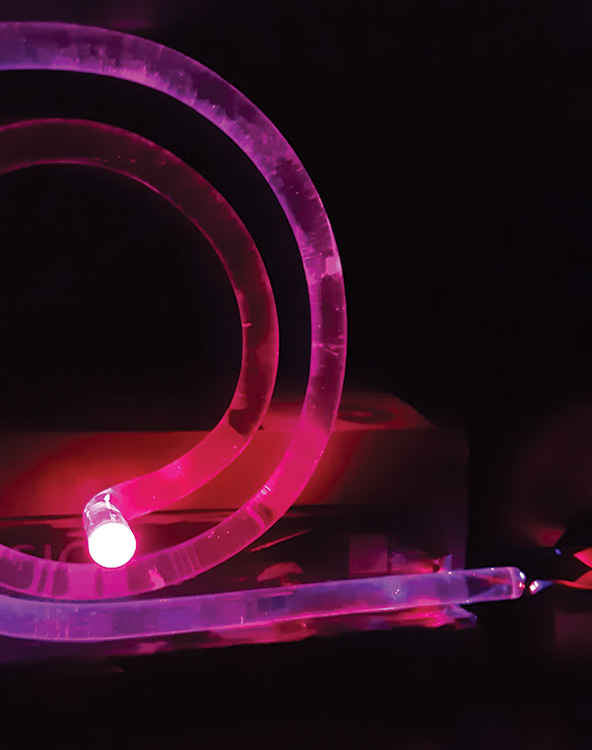
Total Internal Reflection and Colour Theory
When light is coming from a dense medium strikes the surface, part of the light will be reflected, and part will be refracted. The normal line perpendicular to the surface, reflects light coming off at an angle equal to that at which it entered, while the angle for the refracted light is larger than the incident angle. Thus, increasing the angle of incidence, will eventually reach a point where the refracted angle is 90o, light will appear to emerge along the surface between media. If the angle is increased further, it will cause the light to totally internally reflect (TIR), where 100% of the light gets reflected into the denser medium and cannot leave.
Eduard Radut
Victoria Park Collegiate Institute
North York, ON
2018 Art of Physics Competition
High School/CEGEP Individual Category, First Place

Glucomètre en lumière polarisée
Lorsqu’on observe certains affichages à cristaux liquides (ACL) avec des lunettes de soleil polarisantes, on peut parfois observer des patrons colorés. Les ACL classiques sont constitués d’une fine couche de cristaux liquides entre deux filtres polarisants croisés. Quand les cristaux subissent une tension électrique dans l’axe de vision, ils ne polarisent plus la lumière, alors les filtres croisés bloquent la lumière et produisent donc une zone sombre. Par contre, sans cette tension, les cristaux se placent en hélice, deviennent biréfringents et permettent le passage de la lumière entre les deux filtres. Ceci est perçu dans les secteurs gris pâle à côté des caractères ou sur tout l’écran quand l’appareil n’est pas en fonction. En photographiant l’ACL de ce glucomètre avec un filtre polarisant sur l’objectif, on se trouve en fait à observer la photoélasticité de la petite plaque protectrice de plastique qui recouvre l’écran. Cette plaque se retrouve entre deux polariseurs qui permettent de visualiser le stress mécanique qu’elle subit. Ce stress change les propriétés réfractives et de polarisation de la plaque, d’où cet arc-en-ciel. Ce phénomène est la raison principale derrière l’interdiction pour les pilotes d’avion de porter des lunettes polarisantes.
Richard Germain
Pointe-des-Cascades (QC)
Concours L’Art de la Physique 2018
Catégorie Ouvert à tous, Mention honorable
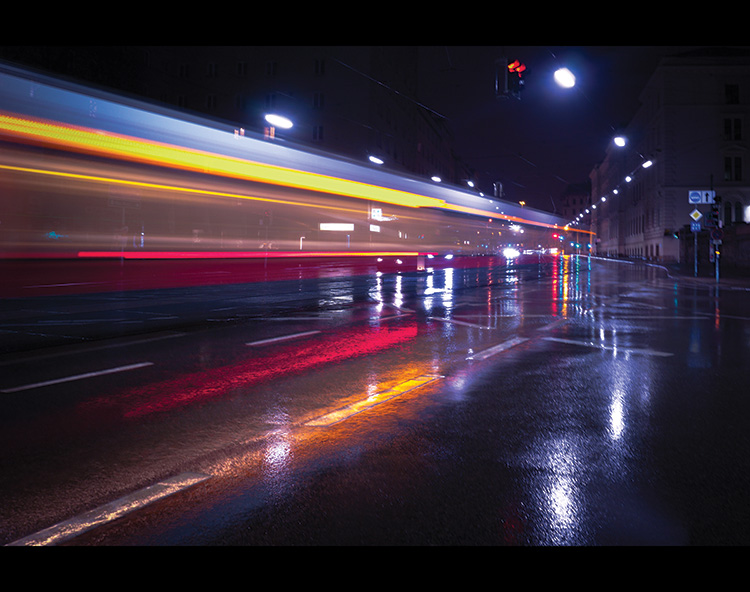
Trails of Light
This is a picture of a tram taken on a rainy night in Vienna during my spring break vacation. It encapsulates how light is captured by a camera over a five-second exposure. There are several streaks of colored light that were created by the tram’s sidelights and brake lights, along with the reflection of the streetlight above. In addition, each source of light is reflected by the wet pavement creating slightly distorted reflections. In this photo, one can also see how long exposure is able to blur out the body of the tram as photons from different positions reach the camera during the five-second interval. As the sensor of the camera is more sensitive to brighter light, the dark body of the tram appears transparent, while the light trails stay solid. This photo showcases both the physics concept of reflection and refraction while also demonstrating the movement of light photons over a period of time.
Edwin Tang
Vancouver, BC
2018 Art of Physics Competition
High School/CEGEP Individual Category, Third Place
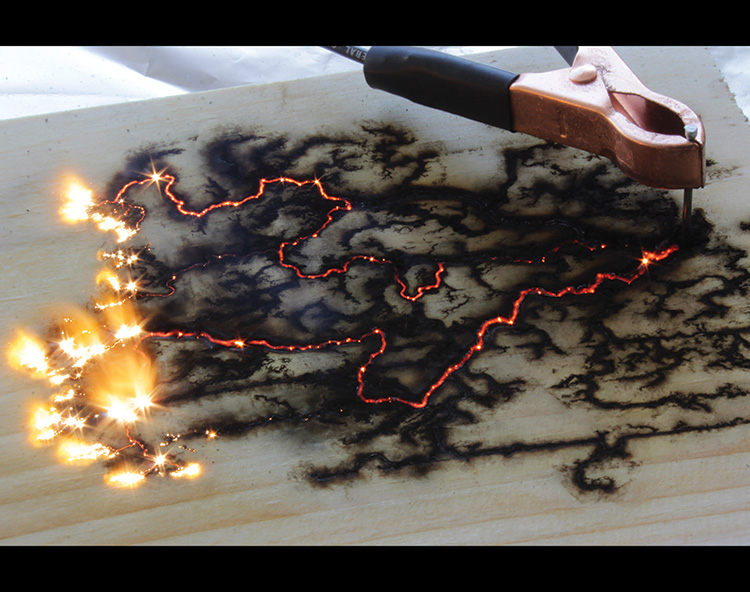
Lightning Patterns on Wood
This photograph shows a Lichtenburg Figure forming on a piece of wood. This repeating pattern is usually seen in lightening and electric sparks. In this photo, a baking soda and water solution was applied onto the surface of a piece of wood. Two iron nails were hammered into opposite ends of the wood, and connected to a high voltage microwave oven transformer. When the transformer was switched on, electricity passed between the nails via the baking soda solution. This was possible because the ions in the baking soda dissociated in the water, allowing the solution to conduct electricity. Although wood is generally an insulator, the high voltage caused it to experience an electrical breakdown, allowing for current to flow through the surface of the wood. This sudden flow of electricity, known as an electrical discharge, caused the wood to heat up and to burn, since electricity passing through resistance generates heat. Once the wood started to burn, carbonized tree-like paths were created, which spread out and moved towards the opposite iron nail. The bright orange lines in the photo are paths of conduction for the electricity. The final result was a magnificent fractal pattern, known as Lichtenburg Figure.
Ching Ho Leung
Markville Secondary School
Markham, ON
2018 Art of Physics Competition
High School/CEGEP Individual Category, Second Place
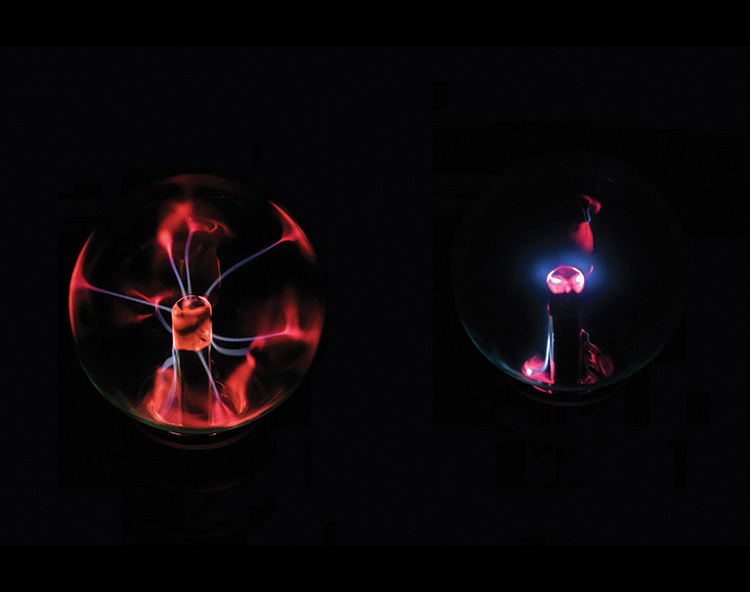
The Magnetic Pick-pocketing of Electricity
The picture depicts two identical plasma balls which are turned on. The globe on the left is unaltered whereas the globe on the right has a powerful neodymium magnet on top of its mechanical switch. As we can see, the magnet has caused the plasma ball to lose its intensity and also cause a change in colour of the discharge currents. The change can be attributed to the interaction between a magnetic field and an electrical current. The current in the plasma ball induces a magnetic field due to electromagnetic induction which interacts with the magnetic field of the neodymium magnet. The two magnetic fields are either the same or opposite polarity which results in the flow of electrons being attracted to, or repelled by the magnet. As the neodymium magnet has a much stronger magnetic field than the current, the majority of the current falls off the circuit, thus only a fraction of the current is able to be discharged into the globe. Lastly, the plasma filament changes colour as it does not have enough energy to completely ionize the noble gas, resulting in a low energy/different colour discharge.
Prabhav Desai
Sir Winston Churchill H.S.
Calgary, AB
2018 Art of Physics Competition
High School/CEGEP Individual Category, Honourable Mention
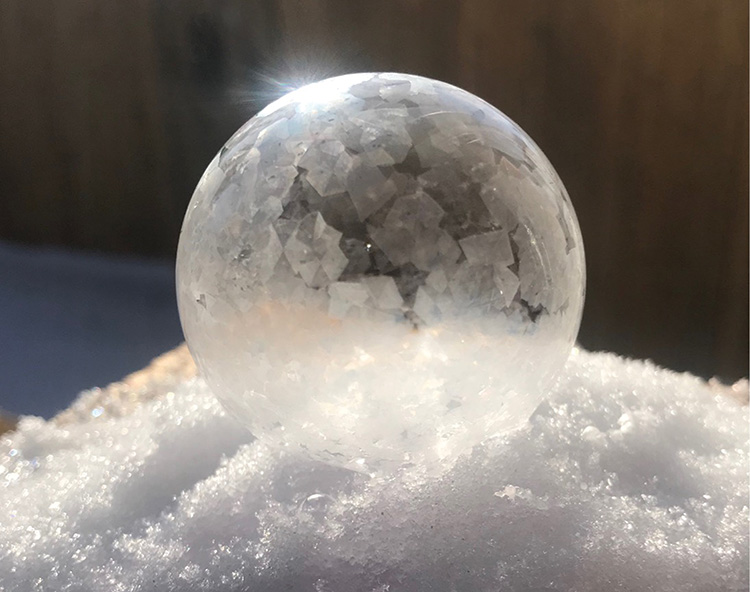
Nature’s Snow Globe
This is a picture of a soap bubble experiencing the extremely cold weather in Toronto. The very low temperature causes crystals to form on the soapy film of the bubble and expand until the bubble itself is frozen. As the crystals grow and spread across the surface, they swirl across the soapy film, making it look like a snow globe! This phenomenon is caused by the imbalance in thermal energy across the soapy film. The process starts at the bottom of the bubble, where the soapy film goes through a rapid phase change from liquid to solid, creating the crystals that we see in the picture. The phase change releases latent heat which remains at the bottom of the bubble since the film is too thin for the heat to travel elsewhere. Due to this event, the liquid at the base of the bubble is warmer than the liquid at the top, creating currents with the soapy film. As a result of the Marangoni effect, liquid flows from warm to cold to transfer thermal energy. The crystals are dragged away from the bottom of the bubble and are carried along the currents, creating the snow globe effect.
Faizah Islam
Victoria Park Collegiate Institute
Toronto, ON
2018 Art of Physics Competition
High School/CÉGEP Class Project Category, 1st Place
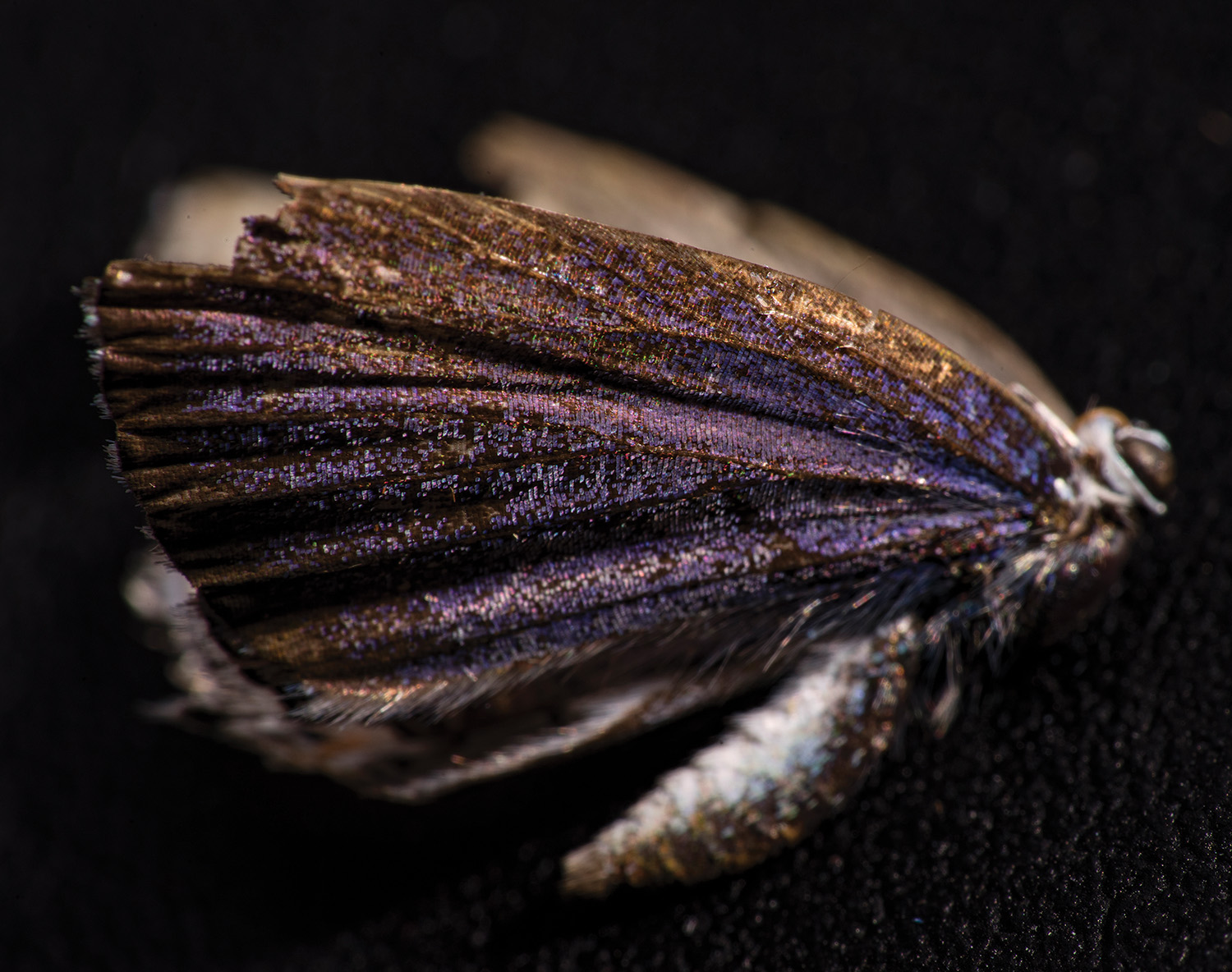
Aile de Lycaenidae Polyommatinae Thersite
Certains papillons utilisent des techniques autres que la pigmentation pour obtenir les couleurs que nous voyons, soit l’iridescence. Sur la photo, nous pouvons observer que les ailes sont recouvertes de petites écailles striées de plis et enchevauchées comme des ardoises. Leur configuration structurelle peut uniquement renvoyer certaines longueurs d’onde dans une direction donnée, on obtient alors une couleur structurelle. Des interférences se produisent grâce à un empilement de couches nanométriques, alternant chitine et air, produisant des réflexions multiples. Ceci permet la superposition de certaines longueurs d’onde en renforçant leur amplitude et pour d’autres longueurs d’ondes, en s’opposant, elles finissent par s’annuler et disparaître. L’agencement de ces nanostructures sur ces ailes rend possible le phénomène d’iridescence: phénomène optique du changement de couleurs d’une surface selon l’angle de l’observateur. En d’autres mots, un renvoi de la lumière dans toutes les directions avec une longueur d’onde différente. La couleur irisée, une nuance de l’arc-en-ciel, ici nous apparaît violette grâce au réseau de diffraction de la lumière qui est réfléchie par les nanostructures des écailles et de l’angle d’observation.
Yoan Beaulieu
École Secondaire Cité des Jeunes
Saint-Lazare (QC)
Concours L’Art de la Physique 2018
Catégorie projet individuel au niveau secondaire ou cégep,
Mention honorable
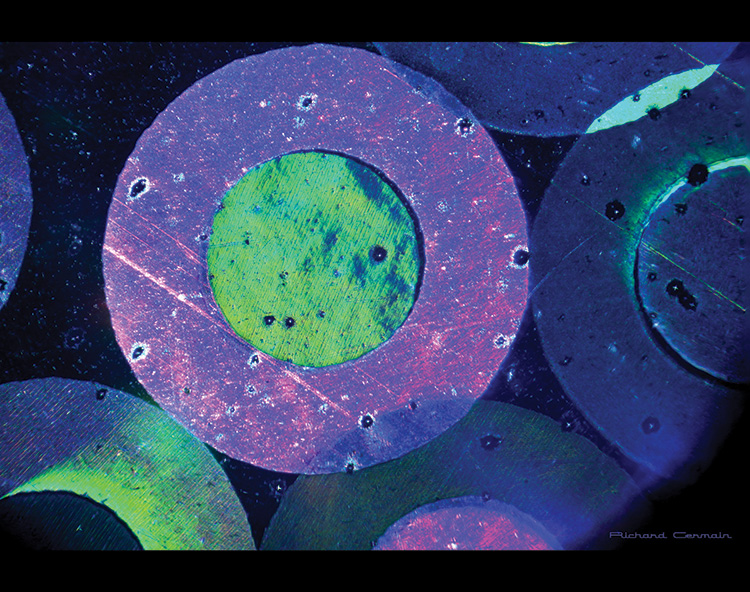
Papier d’emballage iridescent
Certains papiers d’emballage cadeaux ont une surface argentée qui présente des reflets multicolores irisés variant selon les angles d’éclairage et d’observation. Fréquemment, ces papiers sont faussement qualifiés d’holographiques. Cette image montre une section d’environ 2mm x 3mm d’un tel papier photographié au microscope. Le disque central entouré d’un anneau sont tous les deux faits d’une mince couche métallique apposée sur du papier ou sur une pellicule de plastique. Bien que le disque et l’anneau soient éclairés de la même façon, on perçoit des couleurs très différentes. L’observation au microscope permet de voir des structures rainurées sur leur surface, mais dans des axes différents pour le disque et l’anneau. Ces rayures très fines transforment les surfaces métalliques en réseaux de diffraction. En présence de lumière blanche, polychromatique, l’angle d’incidence de l’éclairage et la position de l’observateur (dans ce cas, le microscope muni de l’appareil photo), détermineront si les ondes d’une couleur donnée, réfléchies sur les réseaux, s’additionneront pour produire une interférence constructive ou s’annuleront pour produire une interférence destructive. Alors différentes couleurs apparaitront selon l’orientation du papier et ces couleurs structurelles seront distinctes sur les cercles et les anneaux.
Richard Germain
Pointe-des-Cascades (QC)
Concours L’Art de la Physique 2018
Catégorie Ouvert à tous, 1e Prix
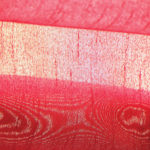
“A birch curtain”
One would think that the photography displays a tree’s trunk, a birch, with some growth rings on the side. In reality, this image taken in the middle of summer season shows the passage of the rays of light through a red translucent curtain behind a window. The series of curves on the side, characterised by a variable light intensity, is the consequence of the physics interference phenomenon, that is, the superposition of light waves through the complex network of weaving that characterises the fabric.
“Le rideau bouleau”
On pourrait croire que la photographie montre le profile d’un arbre, un bouleau, avec, à son côté, des cernes de croissance sur la section d’un arbre. En réalité, l’image prise en pleine saison estivale représente le passage de la lumière solaire à travers des rideaux translucides rouges derrière une fenêtre. La série de courbes visibles sur le côté, caractérisées par une intensité lumineuse variable, est le résultat d’un phénomène physique de l’interférence, c’est à dire, la superposition des ondes lumineuses à travers le complexe réseau de la trame constituant la texture du tissu.
Francesco Barletta
Saint-Tharcisius (QC)
Concours L’Art de la physique 2018
Catégorie Ouvert à tous, Mention honorable
